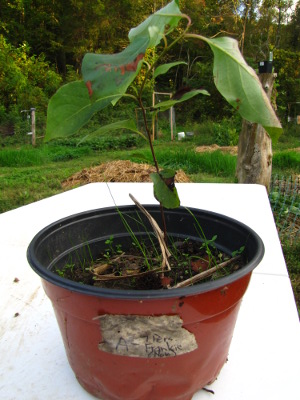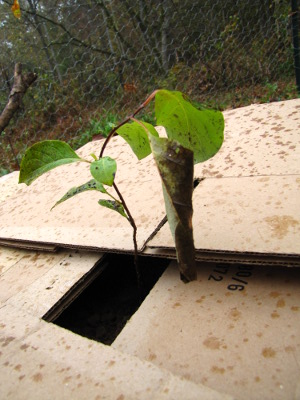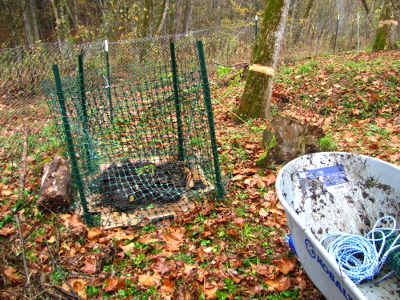
Starting persimmons from seed
 The good news is that I now
have one beautiful little American persimmon growing in our chicken
pasture. The bad news is that I
started with 40 seeds last fall. What happened?
The good news is that I now
have one beautiful little American persimmon growing in our chicken
pasture. The bad news is that I
started with 40 seeds last fall. What happened?
The seeds came from a
variety of sources (thanks, Lisa, Frankie, and Mom!) and I think I
should have been more careful about how the seeds were handled.
The one seed that sprouted came to me inside a freshly picked
persimmon, while many of the unsprouted seeds arrived flesh-free.
Persimmon seeds can die easily if they don't stay moist, so I think
it's quite possible that some of the seeds I planted weren't even
viable when I put them in the ground. In future, I'll be sure to only plant
seeds that have been inside a fruit, in the
gut of an animal, or
inside a damp baggie.
Since I had so many
persimmon fruits from Frankie, I put about a dozen seeds in some  water to ferment off the
flesh the way you do with tomatoes or cucumbers. I was hoping that the
fermenting process would make the seeds more likely to sprout, but none
of that batch made it. Fermenting
persimmon seeds doesn't seem to be helpful.
water to ferment off the
flesh the way you do with tomatoes or cucumbers. I was hoping that the
fermenting process would make the seeds more likely to sprout, but none
of that batch made it. Fermenting
persimmon seeds doesn't seem to be helpful.
Finally, I think the
biggest problem was my planting method. Persimmons hate being
transplanted and are supposed to be very dependent on native forest
mycelium, so I dug up some soil out of the nearby woods, put it in
pots, and planted the seeds inside. Over the winter, these pots
were sitting outside to stratify the seeds, and the frost
heaved the soil until many of the seeds ended up sitting on the surface
and drying out. Since persimmon seeds don't sprout until far into
the summer, I forgot about the pots and the seeds had another chance to
dehydrate. If that combination of mismanagement didn't kill all
of the seeds, it surely must have knocked back the soil fungi, so my
low germination percentage is no big surprise.
 This year, I plan to remove
persimmon seeds from the fruit, wrap them in a damp cloth inside a
ziploc bag, and let them stratify in the more controlled refrigerator
environment.
Only
in the spring will I take them out and put them in pots (in a more noticeable
location!) Alternatively, if I didn't think I'd lose track of
them, I could just plant several seeds in each place where I want
persimmons to grow, then thin back to one plant per patch next summer.
This year, I plan to remove
persimmon seeds from the fruit, wrap them in a damp cloth inside a
ziploc bag, and let them stratify in the more controlled refrigerator
environment.
Only
in the spring will I take them out and put them in pots (in a more noticeable
location!) Alternatively, if I didn't think I'd lose track of
them, I could just plant several seeds in each place where I want
persimmons to grow, then thin back to one plant per patch next summer.
All of these should'ves
aside, I think the one persimmon seedling I set out this week will do
quite well. Of course, I have to wait 4 to 8 years until I know
whether it's a useless boy or a useful girl....
Want more in-depth information? Browse through our books.
Or explore more posts by date or by subject.
About us: Anna Hess and Mark Hamilton spent over a decade living self-sufficiently in the mountains of Virginia before moving north to start over from scratch in the foothills of Ohio. They've experimented with permaculture, no-till gardening, trailersteading, home-based microbusinesses and much more, writing about their adventures in both blogs and books.
Want to be notified when new comments are posted on this page? Click on the RSS button after you add a comment to subscribe to the comment feed, or simply check the box beside "email replies to me" while writing your comment.

We say "Momo, Kuri, san-nen, Kaki hachi-nen." Lit. "Peaches and Chestnuts in three years, and Persimmons in 8."
I am happy to hear that you have a new tree! I love my persimmons, bitter and astringent alike.
A little trick that might work sweetening up your astringent American fruit- We put a little shochu (basically vodka)in a saucer and dip the sepals and stem of the still hard fruits into it. Then put the fruit into a ziplock bag on the counter for 2-3 days. It is still apple hard, but the astringency is gone. Again, I don't know about American varieties, but it works like a dream on Hachiya.
Chestnuts in three years! I didn't realize they came so fast.
We'll be trying out some Asian persimmon varieties this year too, since I learned that there are a few varieties cold hardy enough for U.S. zone 6. They're astringent just like the American ones, so we may end up trying out your tricks. To be honest, though, I'm mostly planting persimmons as late autumn chicken feed...